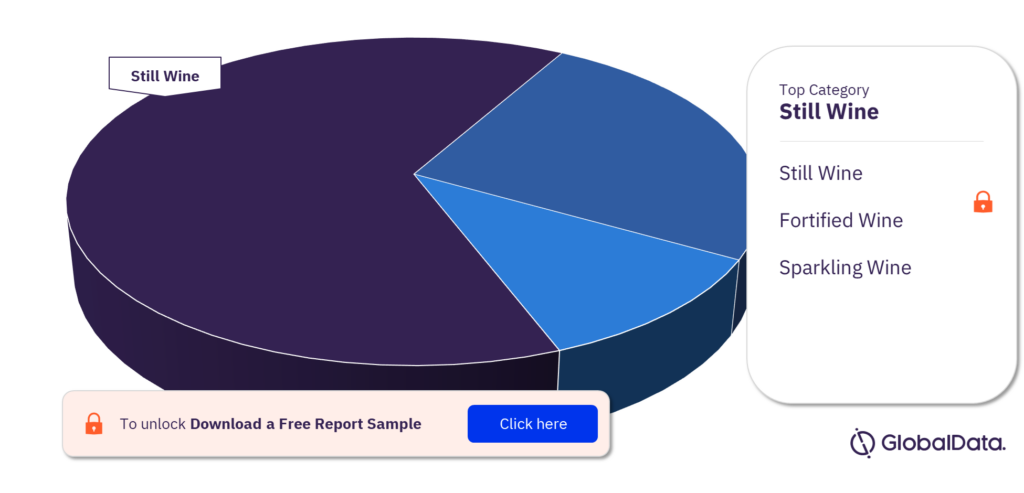The Australian wine market is at an exciting crossroads, with emerging trends like premiumization, sustainability, and digitalization shaping its future. As Australian wineries continue to innovate and diversify their offerings, they will be able to navigate challenges like climate change and trade disruptions. The country's rich wine heritage, combined with a commitment to quality and sustainability, positions Australia as a global leader in the wine industry.

For more category insights, download a free report sample
Key Trends in the Australian Wine Market
Premiumization and the Rise of High-Quality Wines
One of the most notable trends in the Australian wine market is the growing demand for premium wines. Australian wine consumers, both domestically and abroad, are increasingly favoring high-end, limited-edition, and region-specific wines. The shift toward premiumization reflects broader consumer preferences for quality over quantity, with a growing emphasis on craftsmanship, terroir, and sustainability. Iconic wine regions like the Barossa Valley, McLaren Vale, and the Hunter Valley are leading this trend, producing award-winning Shiraz, Cabernet Sauvignon, and Chardonnay wines that are sought after in global markets.Sustainability and Organic Practices
Sustainability has become a central focus for Australian wineries. With an increasing number of consumers seeking environmentally-friendly products, many producers are shifting toward organic, biodynamic, and sustainable wine production practices. The adoption of these practices helps meet the growing demand for wines that align with eco-conscious values. Wineries are using sustainable farming techniques, reducing water usage, and focusing on energy efficiency. The Australian Wine Sustainability Code is helping wineries formalize their commitment to sustainability, making it easier for consumers to identify environmentally responsible brands.Climate Change and Adaptation
Australia’s wine regions are facing significant challenges due to climate change, including hotter temperatures, prolonged droughts, and unpredictable weather patterns. As climate conditions impact traditional wine-growing regions, wineries are exploring ways to adapt by shifting grape cultivation to cooler climates, planting drought-resistant varietals, and experimenting with different growing techniques. In regions like Tasmania and cool-climate vineyards in Victoria, there is a growing trend toward producing cooler climate varietals such as Pinot Noir and Sauvignon Blanc. These regions offer a more sustainable alternative as the global warming effect intensifies.Digitalization and E-Commerce Growth
The COVID-19 pandemic accelerated the adoption of e-commerce in the wine sector, and the trend continues as consumers increasingly turn to online platforms to purchase wine. Direct-to-consumer (DTC) sales through winery websites, subscription models, and online retailers have surged in popularity, particularly among younger consumers. Wine clubs and subscription services have become an important channel for wineries to reach loyal customers. Digitalization is also enabling wineries to engage with consumers more effectively, using tools like virtual wine tastings, online marketing, and social media to promote their products.Expanding Export Opportunities
Australia remains one of the world’s top wine exporters, and the global demand for Australian wines continues to grow, particularly in markets like China, the UK, and the US. However, the Australian wine industry has faced challenges, such as China’s recent tariffs on Australian wines, which have created a need for diversification in export markets. Wineries are increasingly looking to other regions, such as Southeast Asia, Japan, and Europe, to expand their reach. Exporting to these regions requires adapting to local tastes and preferences, with some wineries tailoring their offerings to suit different cultural norms around wine consumption.Innovations in Wine Production
Australian winemakers are embracing technological innovations to improve production processes, enhance wine quality, and reduce costs. Advances in precision agriculture, drone technology, and data analytics are helping vineyards optimize grape production. Innovations such as the use of artificial intelligence (AI) for predicting grape yields and controlling fermentation processes are also becoming more common. Furthermore, wineries are experimenting with new packaging solutions, such as cans and PET bottles, to meet the demand for more sustainable and convenient wine options.
Growth Drivers of the Australian Wine Market
Changing Consumer Preferences
Younger generations are driving a shift in the wine market, with millennials and Gen Z consumers preferring lighter, fresher wines and experimenting with new wine styles. These consumers are more likely to value sustainable and ethical practices, which has encouraged wineries to invest in organic and biodynamic production methods. Additionally, they are showing a growing interest in alternative wine packaging, like cans and eco-friendly bottles.Domestic Demand for Wine Tourism
Wine tourism is a significant contributor to the Australian wine market. With its world-class wine regions and stunning vineyard landscapes, Australia has become a sought-after destination for wine lovers. Wine tourism not only drives domestic sales but also increases international exposure, as visitors to Australia bring attention to the country’s wines when they return home. Wineries are focusing on improving their tourism experiences, offering events, tastings, and vineyard tours to attract both local and international tourists.Government Support and Export Incentives
The Australian government plays a pivotal role in supporting the wine industry, particularly through initiatives that promote exports and innovation. Programs such as Wine Australia’s Export and Marketing Program have been instrumental in increasing the visibility of Australian wines on the global stage. Government support helps Australian wineries access new markets and navigate trade challenges, such as tariffs and export regulations.Global Demand for Australian Shiraz
Shiraz remains one of the most popular and globally recognized Australian wines. Its bold, full-bodied profile and versatility have earned it a dedicated following in key markets like the US and the UK. Australian Shiraz, particularly from regions like the Barossa Valley, is known for its rich fruit flavors and peppery spice, making it a preferred choice among wine enthusiasts. This continued demand for Shiraz supports overall market growth and the reputation of Australian wine globally.














